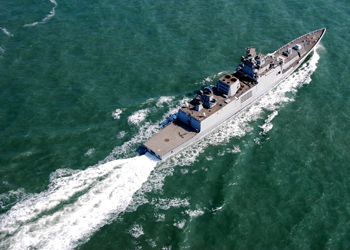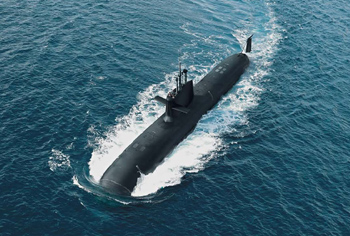INDIAN ARMED FORCES CHIEFS ON OUR RELENTLESS AND FOCUSED PUBLISHING EFFORTS

The insightful articles, inspiring narrations and analytical perspectives presented by the Editorial Team, establish an alluring connect with the reader. My compliments and best wishes to SP Guide Publications.

"Over the past 60 years, the growth of SP Guide Publications has mirrored the rising stature of Indian Navy. Its well-researched and informative magazines on Defence and Aerospace sector have served to shape an educated opinion of our military personnel, policy makers and the public alike. I wish SP's Publication team continued success, fair winds and following seas in all future endeavour!"

Since, its inception in 1964, SP Guide Publications has consistently demonstrated commitment to high-quality journalism in the aerospace and defence sectors, earning a well-deserved reputation as Asia's largest media house in this domain. I wish SP Guide Publications continued success in its pursuit of excellence.
- MoD initiates comprehensive review of Defence Acquisition Procedure 2020, pushes for defence reforms
- G7: The Swansong
- Kalinga Connect: South Asia to Polynesia
- Advanced MRSAM for India for a greater firepower
- Must Credit DRDO for Operation Sindoor, now what is next for defence R&D?
- Operation Sindoor | Day 2 DGMOs Briefing
- Operation Sindoor: Resolute yet Restrained
Indian Navy and Coast Guard's 15-year land warfare capability roadmap


Lead time for naval platforms is by far the maximum among the three services, necessitating far greater foresight for asset accretion. In fact, the Navy's current depleting submarine strength is the result of a combination of factors that hamstrung planners at a crucial phase. The TCPR on maritime technologies, therefore, is particularly focused on futuristic technologies, keeping in mind the lead time necessary to bring assets into the navy.
The document starts by talking about air-launched anti-submarine warfare weapons, which would include the development of super-cavitating air-launched underwater weapons including high speed torpedoes with extended ranges, light-weight air-launched intelligent mines, air-launched torpedoes with ranges greater than 15 km, intelligent air launched torpedoes with loiter and self detection capabilities and weaponisation of UAVs with precision-guided ammunition and missiles. In the sphere of special operations and diving, the technology that the Navy would be interested in include battle management systems for integration of the special operation elements with other naval components in a network-centric environment, hands-free secure real-time voice and data transmitting equipment for tactical and area communication, special purpose craft, RHIBs, vehicles and other associated systems for special operation teams, IR/thermal and optical sights for observation and assault, sniper area weapons, special ops equipment and explosives tailor-made to meet symmetric and asymmetric threats, small arms simulators and indoor combat work-up stations for conduct of work up and training, mine counter measures and explosive ordnance disposal related equipment, ISR equipment, equipment for conduct of underwater salvage operations, recompression chambers (RCCs) and associated systems.
In the realm of coastal security, the technologies of interest include unmanned surface vessels (USVs) for investigation of contacts and patrolling, mobile radar and AIS systems to cover gaps along the coast, capability to track all vessels at sea in IOR, capability to distinguish rogue vessels by contact motion analysis (CMA) and other methods of analysis from the track data, modern high definition radars, better optical sights and night vision devices. Constant underwater surveillance will form an important part of Indian Navy's ability to protect its vessels, personnel and underwater interest from hostile submarines. The Sea Glider can be used to monitor shallow-water environments from fixed positions on the ocean floor or by moving through the water to scan large areas for extended periods of time.
The TPCR document also lists the following as significant for maritime warfare: ship-launched/recovered UAVs and UCAVs with integrated radars/IR/LASER/video surveillance system, LASER based wake detection capability, low frequency transducers for underwater detection, surface-to-subsurface strike capabilities comprising development of long, short and medium range super-cavitating torpedoes, with active homing heads, development of ship fitted guns and mountings with limited surface attack capability to engage unarmed merchant shipping, beach softening, anti air defence, including the CIWS gun mounts (like the Raytheon Phalanx on the INS Jalashwa) capable of engaging the low flying sea skimming missiles, with fire control systems for target acquisition and target identification, improved ammunition with limited precision guidance for increasing the range and lethality of SR/MR guns, towed array, variable depth and seabed surveillance sonar systems and development of higher accuracy RLG based INS systems. Laser communications could be adopted in future to achieve two-way real-time communications with submarines at operational depths, says the document, adding, this technology would also offer exchange of data at very high rates. On the amphibious aircraft front, the document says that these need to be developed for missions like intelligence gathering, HADR, SAR, logistics and communication duties in fleet support, along with conventional aircraft carrier. It also calls for unmanned underwater vehicles (UUVs), where technology in the field of unmanned vehicles can also be used to develop UUVs which could be used as small, high-speed submarine hunters, or mine clearance. "The next generation of submarines could carry a number of UUVs capable of penetrating shallow rivers or canals while the mother submarine lies safely out in deeper water. The UUVs could also be used as forward sensors, as a means to detect minefields or as weapon carriers," the document suggests. On the underwater surveillance front, the thrust in future should be towards development of advanced sonars. In the longer term, it may be possible to depict objects in three dimensions using laser technology.





